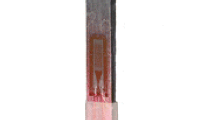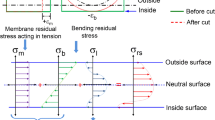Abstract
In the cold roll forming process of complex cross-sectional steel, the local thickness reduction is one of the major problems to be solved for increasing requirements regarding tolerances. The prediction of the local thickness reduction during the roll forming process in the bending zones is gaining more and more importance. Based on the elastic plasticity deformation theory, the 3D finite element analysis (FEA) models have been built by the professional software COPPA RF and MSC MARC to simulate the cold roll forming process. Roll forming tests and the local thickness reduction analyses were performed to compare with FEA simulation results. An application to a hat-shaped section profile and the effect of forming parameters on transverse strains and the local thickness reduction are discussed. The linear regression method was applied to evaluate its effect on the local thickness reduction by using Minitab software. Results indicate that the loading pattern and the roll diameter have the greatest impacts on local thickness reduction and transverse strains in the bending regions. The findings were applied to optimize the abatement of local thickness reduction for the novel elevator guide rail roll forming lines. The predicted thickness reduction values in cold roll forming proves in good agreement with experimental results, and the complex cross-sectional steel with high quality is produced.
Similar content being viewed by others
References
Halmos GT (2006) Roll forming handbook, 1st edn. Taylor & Francis Group. CRC Press, Florida
Wiebenga JH, Weiss M, Rolfe B, van den Boogaard AH (2013) Product defect compensation by robust optimization of a cold roll forming process. J Mater Process Tech 213(6):978–986. https://doi.org/10.1016/j.jmatprotec. 2013.01.006
Horvath CD (2010) Materials, design and manufacturing for lightweight vehicles, 1st edn. Woodhead publishing, Cambridge, pp 35–78
Zhang LL, Tan NL, Liu C (2010) A new model for simulation of cold roll-forming of tubes by using spline finite strip method. J Shanghai Jiaotong Univ (English Edition) 15(1):70–75. https://doi.org/10.1007/s12204-010-8135-5
Hong S, Lee S, Kim N (2001) A parametric study on forming length in roll forming. J Mater Process Tech 113(1): 774–778 113(1–3):774–778. https://doi.org/10.1016/S0924-0136(01)00711-7
Bui QV, Ponthot JP (2008) Numerical simulation of cold roll-forming processes. J Mater Process Tech 202(13):275–282. https://doi.org/10.1016/j.jmatprotec.2007.08.073
Zeng G, Li SH, ZQ Y, Lai XM (2009) Optimization design of roll profiles for cold roll forming based on response surface method. Mater Design 30(6):1930–1938. https://doi.org/10.1016/j.matdes.2008.09.018
Paralikas J, Salonitis K, Chryssolouris G (2010) Optimization of roll forming process parameters-a semi empirical approach. Int J Adv Manuf Tech 47(9-12SI):1041–1052. https://doi.org/10.1007/s00170-009-2252-z
Paralikas J, Salonitis K, Chryssolouris G (2011) Investigation of the effect of roll forming pass design on main redundant deformations on profiles from AHSS. Int J Adv Manuf Technol 56(5–8):475–491. https://doi.org/10.1007/s00170-011-3208-7
Paralikas J, Salonitis K, Chryssolouris G (2009) Investigation of the effects of main roll-forming process parameters on quality for a V-section profile from AHSS. Int J Adv Manuf Technol 44(3–4):223–237. https://doi.org/10.1007/s00170-008-1822-9
Paralikas J, Salonitis K, Chryssolouris G (2013) Energy efficiency of cold roll forming process. Int J Adv Manuf Technol 66(9–12):1271–1284. https://doi.org/10.1007/s00170-012-4405-8
Paralikas J, Salonitis K, Chryssolouris G (2013) Robust optimization of the energy efficiency of the cold roll forming process. Int J Adv Manuf Technol 69(1–4):461–481. https://doi.org/10.1007/s00170-013-5011-0
Cha W, Kim N (2013) Study on twisting and bowing of roll formed products made of high strength steel. Int J Precis Eng Man 14(9):1527–1533. https://doi.org/10.1007/s12541-013-0206-8
Safdarian R, Naeini HM (2015) The effects of forming parameters on the cold roll forming of channel section. Thin Wall Struct 92:130–136. https://doi.org/10.1016/j.tws.2015.03.002
Bidabadi BS, Naeini HM, Tehrani MS, Barghikar H (2016) Experimental and numerical study of bowing defects in cold roll-formed, U-channel sections. J Constr Steel Res 118:243–253. https://doi.org/10.1016/j.jcsr.2015.11.007
Bidabadi BS, Naeini HM, Tafti RA, Barghikar H (2016) Experimental study of bowing defects in pre-notched channel section products in the cold roll forming process. Int J Adv Manuf Technol 87(1–4):997–1011. https://doi.org/10.1007/s00170-016-8547-y
Abeyrathna B, Rolfe B, Hodgson P, Weiss M (2017) Local deformation in roll forming. Int J Adv Manuf Technol 88(9–12):2405–2415. https://doi.org/10.1007/s00170-016-8962-0
Abeyrathna B, Rolfe B, Weiss M (2017) The effect of process and geometric parameters on longitudinal edge strain and product defects in cold roll forming. Int J Adv Manuf Technol 92(1–4):743–754. https://doi.org/10.1007/s00170-017-0164-x
Traub T, Chen X, Groche P (2017) Experimental and numerical investigation of the bending zone in roll forming. Int J Mech Sci 131-132:956–970. https://doi.org/10.1016/j.ijmecsci.2017.07.056
Panton SM, Duncan JL, Zhu SD (1996) Longitudinal and shear strain development in cold roll forming. J Mater Process Tech 60(1–4):219–224
Sheikh MA, Palavilayil RR (2006) An assessment of finite element software for application to the roll-forming process. J Mater Process Tech 180(1–3):221–232. https://doi.org/10.1016/j.jmatprotec.2006.06.009
Pastor MM, Bonada J, Roure F, Casafont M (2013) Residual stresses and initial imperfections in non-linear analysis. Eng Struct 46:493–507. https://doi.org/10.1016/j.engstruct.2012.08.013
Zou TX, Zhou N, Peng YH, Tang D, Li DY (2016) Numerical simulation of the roll forming process of aluminum folded micro-channel tube. J Phys: Conference Series, IOP Publishing 734(3):32016
Bernuzzi C, Maxenti F (2015) European alternatives to design perforated thin-walled cold-formed beam–columns for steel storage systems. J Constr Steel Res 110:121–136. https://doi.org/10.1016/j.jcsr.2015.02.021
Zeng G, Lai XM, ZQ Y, Lin ZQ (2009) Numerical simulation and sensitivity analysis of parameters for multistand roll forming of channel section with outer edge. J Iron Steel Res Int 16(1):32–37
Henninger F, Friedrich K (2004) Production of textile reinforced thermoplastic profiles by roll forming. Compos Part A-Appl S 35(5):573–583. https://doi.org/10.1016/j.compositesa.2003.12.001
Saffe SNBM, Nagamachi T, Ona H (2014) Residual stress around cut end of hat steel channel by roll forming. Procedia Eng 81:239–244. https://doi.org/10.1016/j.proeng.2014.09.157
Ona H, Liu JY (2008) Cold forming technology, 1st edn. Chemical Industry Press, Beijing, pp 9–11
Wang XJ (1994) The production and application of roll formed section steel, 1st edn. Metallurgical Industry Press, Beijing, pp 282–286
Weiss M, Abeyrathna B, Gangoda DS, Mendiguren J, Wolfkamp H (2017) Bending behaviour and oil canning in roll forming a steel channel. Int J Adv Manuf Technol 91(5–8):2875–2884. https://doi.org/10.1007/s00170-016-9892-6
Rossi B, Degée H, Boman R (2013) Numerical simulation of the roll forming of thin-walled sections and evaluation of corner strength enhancement. Finite Elem Anal Des 72:13–20. https://doi.org/10.1016/j.finel. 2013.04. 002
Muller M, Barrans SM, Blunt L (2011) Predicting plastic deformation and work hardening during V-band formation. J Mater Process Tech 211(4):627–636. https://doi.org/10.1016/j.jmatprotec.2010.11.020
Park JC, Yang DY, Cha MH, Kim DG, Nam JB (2014) Investigation of a new incremental counter forming in flexible roll forming to manufacture accurate profiles with variable cross-sections. Int J Mach Tool Manu 86:68–80. https://doi.org/10.1016/j.ijmachtools.2014.07.001
Abvabi A, Rolfe B, Hodgson PD, Weiss M (2015) The influence of residual stress on a roll forming process. Int J Mech Sci 101-102:124–136. https://doi.org/10.1016/j.ijmecsci.2015.08.004
Hellborg S (2007) Finite element simulation of roll forming. Linköping University, Master Thesis
Alsamhan A, Pillinger I, Hartely P (2004) The development of real time re-meshing technique for simulating cold-roll-forming using FE methods. J Mater Process Tech 147(1):1–9. https://doi.org/10.1016/S0924-0136(03)00469-2
Liu XL, Cao JG, Chai XT, Liu J, Zhao RG, Kong N (2017) Investigation of forming parameters on springback for ultra high strength steel considering Young’s modulus variation in cold roll forming. J Manuf Process 29:289–297. https://doi.org/10.1016/j.jmapro.2017.08.001
Khalaj G, Pouraliakbar H, Jandaghi MR, Gholami A (2017) Microalloyed steel welds by HF-ERW technique: novel PWHT cycles, microstructure evolution and mechanical properties enhancement. Int J Pres Ves Pip 152:15–26. https://doi.org/10.1016/j.ijpvp.2017.04.003
Jandaghi MR, Pouraliakbar H, Shiran MKG, Khalaj G, Shirazi M (2016) On the effect of non-isothermal annealing and multi-directional forging on the microstructural evolutions and correlated mechanical and electrical characteristics of hot-deformed Al-Mg alloy. Mater Sci Eng A 657:431–440. https://doi.org/10.1016/j.msea. 2016.01.056
Pouraliakbar H, Pakbaz M, Firooz S, Jandaghi MR, Khalaj G (2016) Study on the dynamic and static softening phenomena in Al–6Mg alloy during two-stage deformation through interrupted hot compression test. Measurement 77:50–53. https://doi.org/10.1016/j.measurement.2015.08.033
Jandaghi MR, Pouraliakbar H (2017) Study on the effect of post-annealing on the microstructural evolutions and mechanical properties of rolled CGPed aluminum-manganese-silicon alloy. Mater Sci Eng A 679:493–503. https://doi.org/10.1016/j.msea.2016.10.054
Pouraliakbar H, Jandaghi MR, Khalaj G (2017) Constrained groove pressing and subsequent annealing of Al-Mn-Si alloy: microstructure evolutions, crystallographic transformations, mechanical properties, electrical conductivity and corrosion resistance. Mater Design 124:34–46. https://doi.org/10.1016/j.matdes. 2017.03. 053
Pouraliakbar H, Firooz S, Jandaghi MR, Khalaj G, Amirafshar A (2014) Combined effect of heat treatment and rolling on pre-strained and SPDed aluminum sheet. Mater Sci Eng A 612:371–379. https://doi.org/10.1016/j. msea.2014.06.044
Pouraliakbar H, Jandaghi MR, Baygi SJM, Khalaj G (2017) Microanalysis of crystallographic characteristics and structural transformations in SPDed Al-Mn-Si alloy by dual-straining. J Alloy Compd 696:1189–1198. https://doi.org/10.1016/j.jallcom.2016.12.086
Jandaghi MR, Pouraliakbar H, Khalaj G, Khalaj M, Heidarzadeh A (2016) Study on the post-rolling direction of severely plastic deformed aluminum-manganese-silicon alloy. Arch Civ Mech Eng 16(4):876–887. https://doi.org/10.1016/j.acme.2016.06.005
Liu CF, Zhou WL, XS F, Chen GQ (2015) A new mathematical model for determining the longitudinal strain in cold roll forming process. Int J Adv Manuf Technol 79(5–8):1055–1061. https://doi.org/10.1007/s00170-015-6845-4
Sun Y, Li YG, Daniel WJT, Meehan PA, Liu ZB, Ding SC (2017) Longitudinal strain development in chain-die forming AHSS products: analytical modelling, finite element analysis and experimental verification. J Mater Process Tech 243:322–334. https://doi.org/10.1016/j.jmatprotec.2016.12.019
Qian Z, Sun Y, Meehan PA, Daniel WJT, Ding SC (2017) Experimental and numerical investigation of flange angle in chain-die formed AHSS U-channel sections. Int J Adv Manuf Tech 92(1–4):1231–1242. https://doi.org/10.1007/s00170-017-0159-7
Sun Y, Li Y, Liu Z, Daniel WJT, Shi L, Meehan PA, Ding SC (2017) Experimental investigation and prediction of the maximum edge longitudinal membrane strain and springback of chain-die-formed AHSS U-channels using response surface methodology. Int J Adv Manuf Tech 90(5–8):1963–1976. https://doi.org/10.1007/ s00170-016-9522-3
Navidi W (2011) Statistics for engineers and scientists, Third edn. McGraw-Hill, New York
Funding
The authors would like to acknowledge the financial support provided by the Innovation Method Fund of China (2016IM010300) and Lvyang Jinfeng Program for the Innovation Leading Talents (yzlyjfjh2015CX055).
Author information
Authors and Affiliations
Corresponding author
Rights and permissions
About this article
Cite this article
Liu, Xl., Cao, Jg., Chai, Xt. et al. Experimental and numerical prediction of the local thickness reduction defect of complex cross-sectional steel in cold roll forming. Int J Adv Manuf Technol 95, 1837–1848 (2018). https://doi.org/10.1007/s00170-017-1279-9
Received:
Accepted:
Published:
Issue Date:
DOI: https://doi.org/10.1007/s00170-017-1279-9




